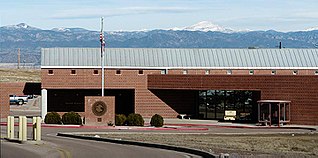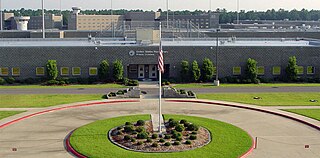
The United States Penitentiary, Administrative Maximum Facility, commonly known as ADX Florence or the Florence Supermax, is an American federal prison in Fremont County to the south of Florence, Colorado, operated by the Federal Bureau of Prisons, a division of the United States Department of Justice. ADX Florence, constructed in 1994 and opened one year later, is classed as a supermax or "control unit" prison, that provides a higher, more controlled level of custody than a regular maximum security prison. ADX Florence forms part of the Federal Correctional Complex, Florence, which is situated on 49 acres of land and houses different facilities with varying degrees of security, including the adjacent United States Penitentiary, Florence High.

A super-maximum security (supermax) or administrative maximum (ADX) prison is a "control-unit" prison, or a unit within prisons, which represents the most secure level of custody in the prison systems of certain countries.
Millhaven Institution is a maximum security prison located in Bath, Ontario. Approximately 500 inmates are incarcerated at Millhaven.

A prison officer (PO) or corrections officer (CO), also known as a correctional law enforcement officer or less formally as a prison guard, is a uniformed law enforcement official responsible for the custody, supervision, safety, and regulation of prisoners. They are responsible for the security of the facility and its property as well as other law enforcement functions. Most prison officers or corrections officers are employed by the government of the jurisdiction in which they operate, although some are employed by private companies that provide prison services to the government.

A prison escape is the act of an inmate leaving prison through unofficial or illegal ways. Normally, when this occurs, an effort is made on the part of authorities to recapture them and return them to their original detainers. Escaping from prison is also a criminal offense in some countries, such as the United States and Canada, and it is highly likely to result in time being added to the inmate's sentence, as well as the inmate being placed under increased security that is most likely a maximum security prison or supermax prison. In Germany, and a number of other countries, it is considered human nature to want to escape from a prison and it is considered as a violation of the right of freedom, so escape is not penalized in itself.
Pontiac Correctional Center, established in June 1871, is an Illinois Department of Corrections maximum security prison for adult males in Pontiac, Illinois. The prison also has a medium security unit that houses medium to minimum security inmates and is classified as Level 3. Until the 2011 abolition of the death penalty in Illinois, the prison housed male death row inmates, but had no execution chamber. Inmates were executed at the Tamms Correctional Center. Although the capacity of the prison is 2172, it has an average daily population of approximately 2000 inmates.

Thomas Edward Silverstein was an American criminal who spent the last 42 years of his life in prison after being convicted of four separate murders while imprisoned for armed robbery, one of which was overturned. Silverstein spent the last 36 years of his life in solitary confinement for killing corrections officer Merle Clutts at the Marion Penitentiary in Illinois. Prison authorities described him as a brutal killer and a former leader of the Aryan Brotherhood prison gang. Silverstein maintained that the dehumanizing conditions inside the prison system contributed to the three murders he committed. He was held "in a specially designed cell" in what is called "Range 13" at ADX Florence federal penitentiary in Colorado. He was the longest-held prisoner in solitary confinement within the Bureau of Prisons at the time of his death. Correctional officers refused to talk to Silverstein out of respect for Clutts.

The United States Penitentiary, Florence High is a high-security United States federal prison for male inmates in Colorado. It is operated by the Federal Bureau of Prisons, a division of the United States Department of Justice. USP Florence High is part of the Federal Correctional Complex, Florence, which is situated on 49 acres (20 ha) of land and houses different facilities with varying degrees of security. It is named "Florence High" in order to differentiate it from the United States Penitentiary, Florence ADMAX, the federal supermax prison located in the same complex.
Auckland Prison is a prison facility consisting of medium security and maximum security compounds in Paremoremo, Auckland, New Zealand. The two compounds are separate but located close together in a rural area.
Wilkinson v. Austin, 545 U.S. 209 (2005), is a United States Supreme Court case in which the Court held that while the Due Process Clause of the Fourteenth Amendment gives rise to a liberty interest in not being placed in a Supermax prison, Ohio's procedures for determining which prisoners should be placed there satisfied the requirements of due process.
Red Onion State Prison (ROSP) is a supermax state prison located in unincorporated Wise County, Virginia, near Pound. Operated by the Virginia Department of Corrections (VADOC), it houses about 800 inmates. The prison opened in August 1998.
The Maine State Prison was erected in Thomaston, Maine in 1824 and relocated to Warren in 2002. This maximum-security prison has a capacity of 916 adult male inmates with an average daily population of 900.

The United States Penitentiary, Pollock is a high-security United States federal prison for male inmates in unincorporated Grant Parish, Louisiana. It is part of the Pollock Federal Correctional Complex and operated by the Federal Bureau of Prisons, a division of the United States Department of Justice. The facility also has an adjacent satellite prison camp for minimum-security male offenders.
The Edmonton Institution is a maximum security federal institution located in the northeastern part of Edmonton, Alberta. It is operated by Correctional Service of Canada. It is part of the Prairie Regions institutions, the Regional Headquarters is located in Saskatoon, Saskatchewan
Erin J. Sharma is a former corrections officer for the United States Federal Bureau of Prisons. She was sentenced to life in federal prison in 2009 for causing the beating death of an inmate at the maximum security unit of the Coleman Federal Correctional Complex near Coleman, Florida. Prosecutors said that after inmate Richard Delano grabbed her arm through a food slot and bruised it, she and another guard arranged for him to be assigned to share a cell with a notoriously violent inmate, knowing Delano would be harmed.
While studies have shown the effects of solitary confinement to be detrimental to some inmates, solitary confinement of women has particular consequences for women that may differ from the way it affects men. Solitary confinement rates for women in the United States are roughly comparable to those for men and about 20% of prisoners will be in solitary confinement at some point during their prison career.
Women have served as prison and correctional officers since the early 19th century in London. The focus of research on female correctional officers has mostly been comparatively discussing the male officers' experience versus the female officer's experience. A number of studies are extensions of interviews or surveys solely of corrections staff and commonly emphasize employment opportunities and working conditions with an inclusion of legal and social obstacles, such as differing types of discrimination, that female officers face on a regular basis, in their respective field. Increased interest in the distinction of gender for workers in correctional facilities has some relevance to the shift in this occupation being predominantly male-dominated to, in some cases, being more female-dominated. The increase in the number of females working in this field is mainly due to helping alleviate staff shortages and providing women seeking employment with more opportunities to work in the correctional system.

Jailbirds is an American reality television series about female inmates at the Sacramento County Jail, California, which premiered on Netflix in 2019. It documents the lives of female inmates of Sacramento County Jail in California, which has just under 2,400 inmates. The show aired a single season with six episodes in 2019, revealing to the audience various prisoners dealing with the reality of "their life being turned upside down" in jail as expressed by executive producer Drachkovitch when questioned on the prison environment. The production focused on aspects of prison life including violence, isolation and newfound relationships.

The Fresno County Jail is a detention center made up of three different adjacent complexes, located at 1225 M. Street, in downtown Fresno, California, operated by the Fresno County Sheriff's Department. The facility is made up of the Main Jail, the North Annex Jail, and the South Annex Jail and is connected by an underground system of tunnels providing easy and safe transportation of inmates. These tunnels also connect to the nearby Fresno County Courthouse. As of March 31, 2020, the Fresno County Jail had 2,746 inmates with 2,490 being male and 256 being female. The Fresno County Jail has recorded the highest number of deaths out of any county jail in California.

The Soldiers of Aryan Culture (SAC), sometimes referred to as Soldiers of the Aryan Culture and Soldiers of an Aryan Culture, is a large American white supremacist prison gang.










